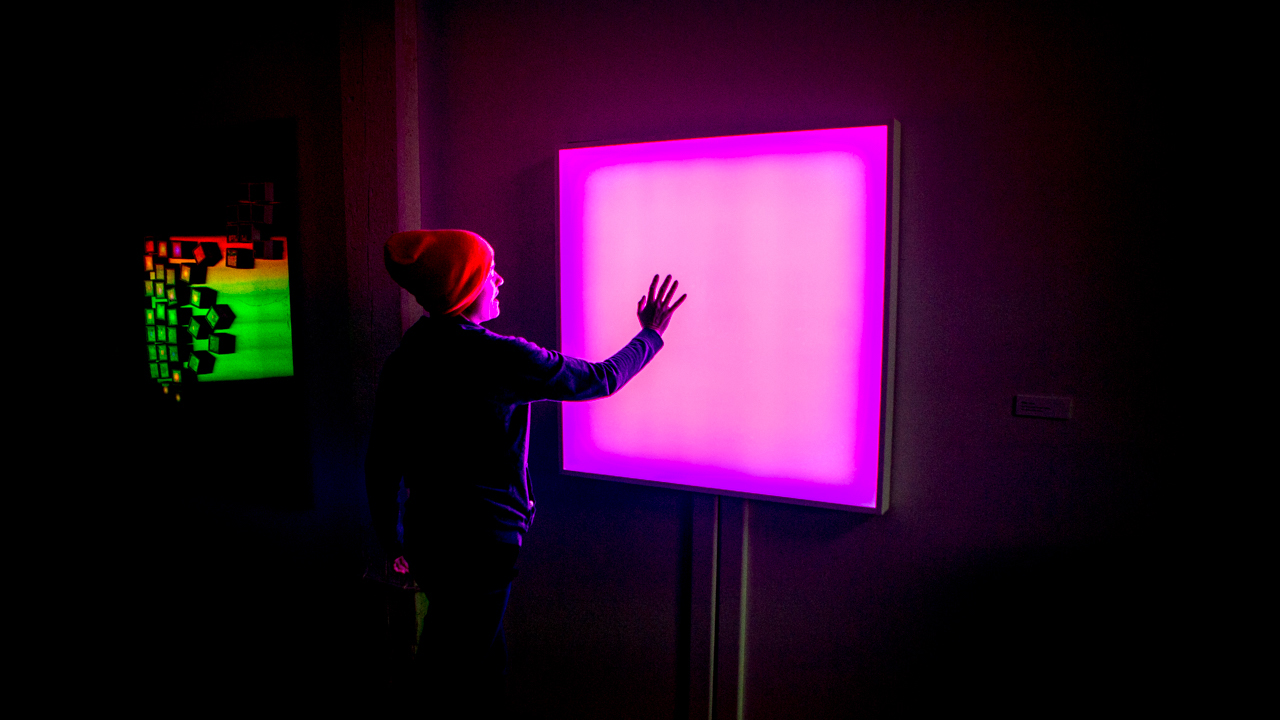In his new exhibition, “No There There,” Jamie Zigelbaum explores the spaces that simultaneously exist and do not exist.
The title of the show comes from a Gertrude Stein quote about visiting her childhood home as an adult. Some took her comment that “there is no there there” in Oakland, California as a kind of snide diss on the city. In reality, she was commenting on the place where she grew up not resembling the place that is there now. The Oakland of her memory was no longer there, it was only in her memory; two distinct places attempting to exist at the same time. Likewise, Zigelbaum’s exhibition collects several pieces that evoke an imaginary space as well as a paradox. Using a variety of techniques and beautifully designed setups, the artist created a number of intriguing experiences and thought experiments.

The first piece you encounter at Transfer Gallery is called Doorway to the Soul. It consists of a small screen with someone staring at you. The artist is paying people on Amazon’s odd jobs site Mechanical Turk to just stare into a webcam for 1 minute each, a task for which they are paid 25 cents. As one can imagine, the sensation of looking into someone’s eyes is not present. Bored, emotionless dudes who are just doing random duties to make a buck are looking straight at you, but they can’t see you and there’s certainly no connection. It’s the antithesis of Marina Abramovic’s famous sit and stare marathons at MOMA.

Next up is a tangled mess of elaborate wiring that connects twenty small screens that are all playing a different section of a movie. Titled Sequence In Parallel, the work allows you to watch a full film in 1/20th of the time but of course you really don’t and really can’t. Now matter how intense your “soft eyes” approach to viewing the work is, you’ll always end up focusing on only a section and will inevitably miss the whole. The artist told ANIMAL that his ultimate goal for the piece is for the collector to load up whatever film they want, further separating the form and the content.

On the opposite wall of the gallery, two variations on a single theme glow with a soothing pulse. Pixel and Six-Forty by Four-Eighty are both attempts to blow up a “pixel” to monumental proportions and allow the viewer to interact with the tiniest building block of every digital image. Pixel is one big ass square that changes color based on the viewers promiximity, while Six-Forty by Four-Eighty is composed of a bunch of smaller “pixels” magnetically attached to a steel plate. Anyone is free to arrange the glowing devices however they like and they change color by touching two at a time. These two pieces are as calm and meditative as the previous wall was unnerving and erratic.

To the left of the pixels is a large sculpture that consists of a flat screen tv sliced into 40 squares that will inevitably remind you of pixels. It’s called My Television and it indeed was the artist’s television for many years. Zigelbaum says, “The cutting of the television like this highlights the irreality of the images I viewed on it.” At first glance, the piece seems to be the weakest in the show but the artist’s explanation probably best exemplifies the overall idea of a Schrodinger’s cat-like space where things do and don’t exist.

The last piece at the back of the gallery is by far the highlight of the show. 100 Hours per Minute displays a unique hashtag beside a giant stack of screens. The viewer can tweet that hashtag with any search term, such as “leave britney alone.” An algorithm then pulls the top results from YouTube and displays them on the big screen simultaneously, all layered on top of each other. The results vary but it mostly becomes an abstract wash of color with recognizable elements here and there. After a hashtag is used a new one is generated, so the only people who can control the piece through cyberspace are the ones viewing it in person at the physical space.

Again, the feeling of seeing but not seeing and being in one place but projecting into another is pervasive. The user has to publicly broadcast a cryptic tweet that won’t make too much sense to their followers and indeed anyone who sees it will be excluded from the experience unless they drag their real ass down to the real world location in meat-space. Communication without communicating, connection without connecting and presence without being present. These aren’t binaries they’re a third thing and Zigelbaum succeeds in his stated intent of getting viewers to reconsider “the false dichotomy of the natural and the digital.”
Jamie Zigelbaum, No There There at Transfer Gallery, Brooklyn from Jan. 24th – Feb. 21st
(Photos: Aymann Ismail/ANIMAL New York)


